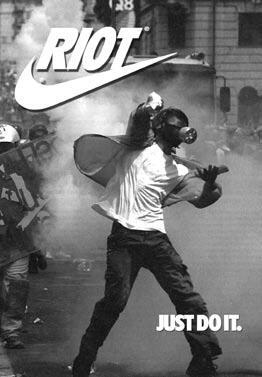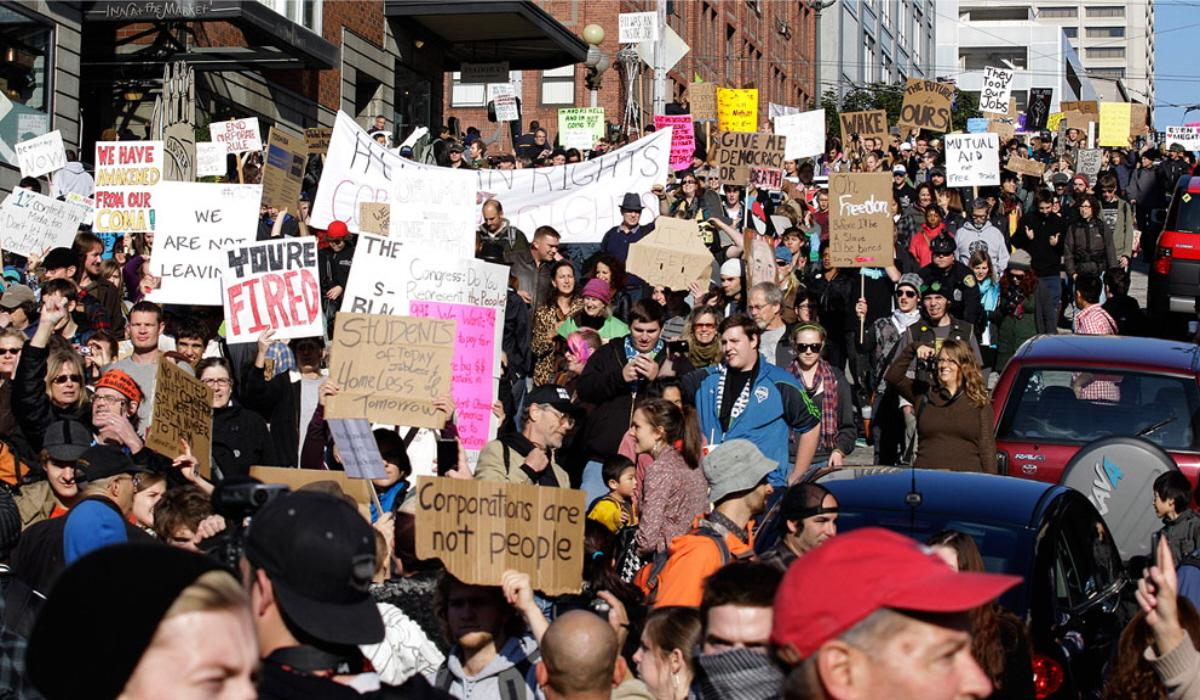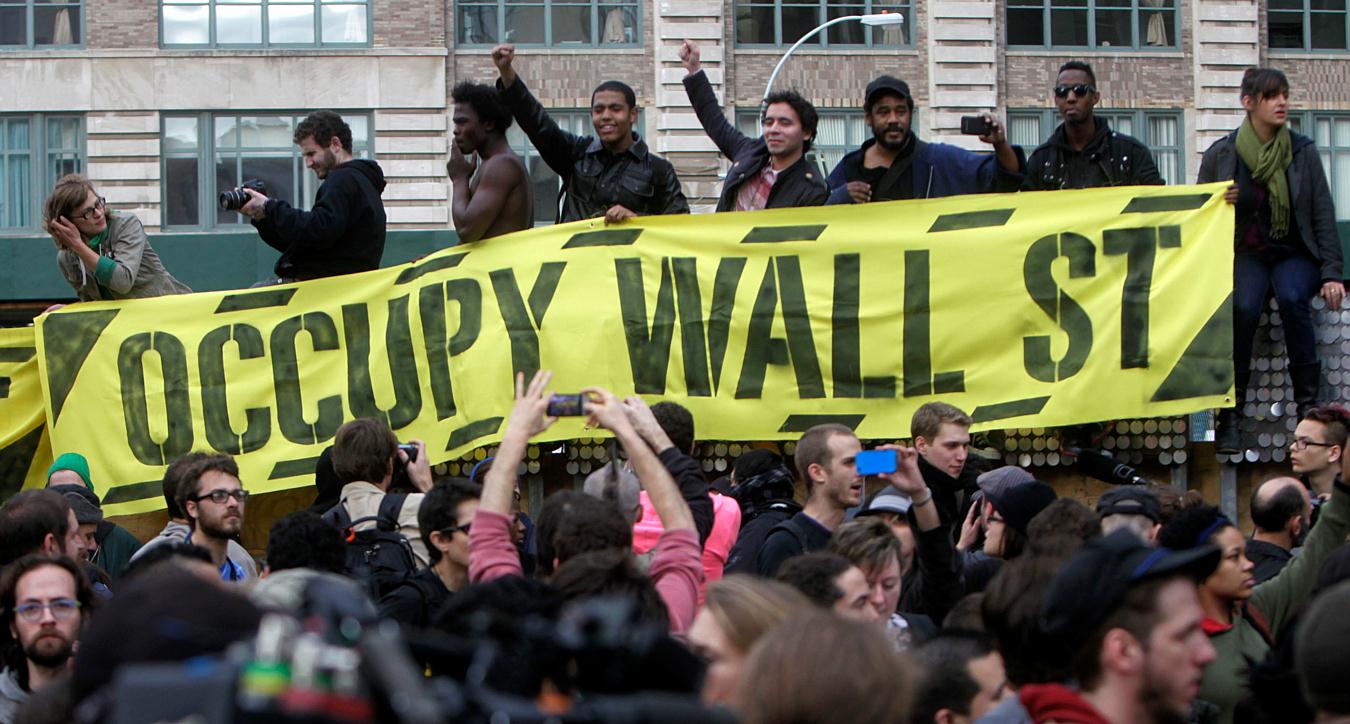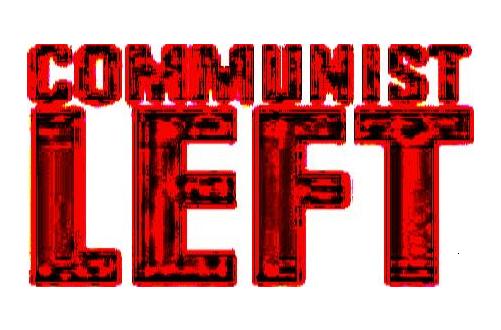All over the world, events are keeping up with the pace of a crisis, the end of which was just recently cheerfully proclaimed by people who thought ludicrous amounts of sovereign debt to be the recipe for an economic miracle. By racking up debt to their ears, governments worldwide were able to contain the so-called financial crisis; but then, the rating agencies presented them a bill that they promptly passed on to wage workers. The whole maneuver did not lead to recovery but to an even more menacing state budget crisis, the handling of which through uncompromising austerity measures has aroused anger. Resistance is mounting. We are at the threshold of a social crisis.
Those who feel the effects of the governments’ austerity programs in their everyday life are starting to realize ever more clearly that these are not temporarily painful, yet necessary sacrifices. They are becoming aware of the fact that the drastic cuts will not only last for years or even decades, but that their own future is becoming ever bleaker. We are probably at the start of a new era: Ever since society was brought back down to the earth of cold hard economic facts, the culturalist carnival of differences has come to an end. Society’s colorful superstructure has scaled off to reveal, in Orthodox Marxist terms, the drab, universal base. And the crisis has achieved what activists striving to link struggles have been incapable of for decades: millions have taken to the streets simultaneously with the same purpose. All they’re left with is an ever more precarious survival under the reigning conditions. For them, it’s all or nothing.
The widely feared collapse of the financial markets was prevented by extensive governmental interventions; exorbitant stimulus packages were able to stabilize industry and even effectuate momentary economic upswings here and there. Germany, in particular, was able to establish itself as a profiteer of the crisis at the cost of the weakened competitors due to its momentary export boom, at the same time becoming the leading advocate of the austerity doctrine. The determined efforts to tackle the crisis failed nonetheless; the problem was merely shifted to the state level and the banking crisis has molted into a sovereign debt crisis, which threatens to break the Euro zone.
At first, Greece drew most of the attention. Unable to raise new money on the financial market on its own, the Greek government was forced to officially request financial help. The troika, consisting of the European Union, the European Central Bank, and the international Monetary Fund granted the Greek state a loan amounting to 110 billion Euros, but this soon turned out to be insufficient.
The Euro’s tumble continued and in May 2010, European heads of government agreed on a European Stabilization Mechanism worth 750 billion Euros to prevent sovereign default by any member of the Euro zone. Above all, the so-called PIIGS, that is Portugal, Ireland, Italy, Greece, and Spain, are thought to be in danger. But even such massive measures were unable to halt the crisis.
Meanwhile, there is now talk of allowing Greece to default, although the consequences for the Euro zone’s future are unknown. If Greece defaults, Greek banks and pension funds will be hit first, as they own about 50% of the government’s bonds and a bailout by the Greek state would, of course, be out of question. Beyond that, important banks in Belgium, France, and Germany would also be in imminent danger, as they, too, hold considerable numbers of Greek bonds in their portfolios. However, the magnitude of the calamity cannot be measured simply as the sum of the shaky government bonds; the crucial point is that these bonds, in turn, serve as securities for further loans, which would no longer be secured as a result of national bankruptcy. Because of these interdependences, which indirectly affect the whole of the European banking sector, banks directly hit by a Greek sovereign default would not be the only ones in danger. Rather, in the medium term, a collapse of the Euro would be possible, which is why negotiations about a recapitalization of European banks with government or EU money are currently taking place. The Euro zone can bear neither a meltdown of the finance sector nor the insolvency of individual members. To keep these things from happening, it is now resorting to leverage techniques. The latter emerged in the mid-1990′s when the trade in financial products was given a boost by enormous numbers of unfunded credit default swaps being sold in the hope that the bloated market could expand just a little more.
Thus, the whole issue keeps spinning in a circle and even the media’s deceptive fragmentation of the crisis into a plethora of crises – real estate crisis, credit crunch, fiscal crisis, sovereign debt crisis, Greece or Ireland crisis, and so on – can hardly hide this. This is because, despite what the talk of ever new individual crises suggests, all of them have the very same origin in the crisis of the real economy. Ever since the post-war boom ran dry in the early 1970′s the rates of profit have been faltering, because ever less living labor keeps ever more dead labor running.(1) The excessive debt the European states and the US started to incur at this point is a symptom of a capitalism losing its economic dynamic; measures originally conceived as a temporary economic stimulus morphed into a permanent policy of subsidies for the productive sectors. However, this policy of excessive deficit spending was unable to sufficiently preserve enticing possibilities for the valorization of surplus masses of capital or to create new ones. Surplus capital gushed into the financial sector, which was bloated more and more until the crisis of 2007/2008 manifested itself as a financial crisis. The bursting of one financial product bubble after another from 2007 on is merely an expression of the scarcity of investment opportunities for capital, which has shot itself in the foot with its permanent technological-scientific upheaval of production.
The cries for a restoration of the “primacy of politics over economics”, which currently dominate the op-ed sections of newspapers and can also be heard in the protest movements, fails to grasp the problem, because they are incapable of understanding the role of banks and lending. They do not only provide the necessary lubricant to keep the accumulation cycle in continuous acceleration; above all, the origin of lending is the part of surplus value that cannot be directly returned into the cycle because of latent over-accumulation. In a sense, the organic way out of the crisis would be a gigantic destruction of capital: bloated financial values would have to be wiped out, banks left to fail; the market would purge itself through company bankruptcies; wage levels would fall even further. After that, the “old filthy business” (Marx) would start from scratch in a new cycle. However, because a laissez-faire policy, which would give such a devaluation free reign appears too risky at the moment even to liberal economists due to its unforeseeable, but certainly drastic consequences, crisis management through state interventions has been the first choice so far. This has led not only to astronomical national debts, but has also cemented the fundamental problem of over-accumulation and merely postponed the unavoidable crash – meanwhile, the stakes keep growing. The increasingly desperate actions of politicians and economists, who, in a climate of ludicrous market fetishization, are behaving like dog trainers unable to cope (“the markets have to be calmed down”, “the markets have to re-gain their confidence”, “be reined in”, “put on a leash” and “put in their place”), reveal to what little extent they are in control of the situation. Their aimless bustle and increasingly open cluelessness and, last but not least, the acquiescence of leading neoliberals to a course of state intervention bear witness to the fact that they have neither a plan nor a clue, but not to the claim, made by Naomi Klein and co, that the crisis is just politics of word choice, designed to serve the “ruling class” in its quest to advance the “neoliberal project”. The same is true of talk of a lack of an alternative to the austerity programs. This lack of an alternative is not merely a rhetorical trick to serve the class struggle from above; in fact, the wiggle room for state actions keeps getting smaller. It has been exhausted in the past decades by necessary subsidies and stimulus programs, particularly since the onset of the crisis in 2007/08.
The most indebted countries are forced to push through the decreed cuts; giving in to the demands of social movements would be construed as weakness and incapacity and cause their position to deteriorate even further. Even in countries that are not immediately threatened by state bankruptcy, re-consolidating state finances is a must, as they have to be prepared to absorb the costs of preventing the collapse of further banks, in order to prevent the meltdown of the financial sector.
Considering this, the prospects for reformist politics are scant. The austerity programs being pushed through tooth and nail are, of course, attacks on the proletarianized, whose livelihoods are increasingly being taken away or cut radically. In Greece the suicide rate – thus far the lowest in Europe – rose by more than forty percent in the past year. In the US, 28 million people received food stamps before the onset of the crisis; in July of 2011 there were 45 million, about 15 percent of the population. They receive an average of 134 dollars; six million of them have no other means of income.
By that standard, the resistance by wage earners has been rather meek. A first wave of protests starting in the fall of 2010 relied primarily on the traditional means of resistance, but they were no match for the state’s keenness to push through the programs. The protests started in France, where a pension reform sparked days of action controlled by the unions and occupations of schools. Most notably, strike and blockades in refineries by workers, unemployed and other discontent people caused gasoline shortages in France. The motto of these actions was bloquer l’économie (“block the economy”), a slogan chanted in part by the rank and file of the CP-allied CGT, much to the dismay of union leaders. But the government stood strong and the pension reform was passed. In late September, a one-day general strike was held in Spain against the relaxation of dismissals protections, after the social democratic government led by Zapatero had already lowered public workers’ wages and frozen pensions, in order to balance the budget. The bill passed. A general strike against an austerity program in Portugal, the first called by both of the two largest unions, the CGTP and the UGT, since 1988, was also unsuccessful. According to the unions’ figures, it was the largest general strike in over twenty years; but the government stated that it has no leeway when it comes to cuts. There were no compromises. In the same month, tens of thousands of British students put up resistance against drastic raises of tuition fees and the education budget being cut by forty percent. In London, the party headquarters of the Tories was attacked; despite the riots, the increases of tuition were pushed through. In Italy, tens of thousands of students protested cuts in education simultaneously by blocking highways and occupying universities; there were intense riots, but the education reforms were passed unamended by both the Chamber of Deputies and the Senate.
The conventional means of class struggle were unable to put enough pressure behind their demands anywhere and the protests failed in every respect despite enormous mobilization efforts. In this climate of social unrest the Arab Spring starting in early 2011 became a formidable beacon and inspired a second wave of protest. The Spanish movement was the first to import the square occupations that had been so successful in Egypt and in Tunisia to Europe. The call for Democracia Real Ya! (“Real Democracy now!”), simultaneously the name of a platform and its most important demand, was able to mobilize masses of indignados (“the indignant”), as they called themselves, to occupy central squares in over a hundred Spanish cities. Following the principles that the Democracia Real platform had propagated – unity of the indignados, decision-making in general assemblies, no open presence of political parties or groups, non-violence – more or less closely, the occupations showed themselves to be collectively capable of spontaneous self-organization and represented a rupture in the everyday lives of the participants, but soon revealed considerable weaknesses related to the form of the action itself. Direct democracy based on the consensus principle turned out to be impractical in assemblies with more than a thousand participants.
Significant discussion was impossible, and a meaningful consensus could not be reached.(2) Moreover, the ideology of non-ideology advocated by the Democracia Real platform was fishy from the start – how could an economic crisis, which then manifested itself as a legitimation crisis thereby gripping the totality of society, be solved with nothing more than a new political form, namely real democracy? In many places this ideology played a part in silencing radical critique and advocating the replacement of politicians, new election laws, ethical banking, and other equally tame demands. An ideology of non-violence that does not even allow for self-defense was shown to be a total failure, at the latest, the moment the police wanted to evict the occupation of Plaça Catalunya in Barcelona and pacifists impeded those attempting to defend it. At least in Barcelona, the central square occupation dissolved in the Summer into neighborhood assemblies that led to loud demonstrations, road blockades and other promising actions from time to time, but were unable to take root in the center of town.
Despite the ambivalent results of the Spanish model, it soon caught on and this form of action spread to other countries. In Greece, where general strikes, occupations and protests had taken place on a regular basis since 2008, often coupled with militancy, the square occupations gained a special kind of momentum. Syntagma Square in Athens was able to exert enough pressure to force the two major union federations ADEDY and GSEE to comply with the occupiers’ call for a general strike; a novelty, not just because one of the general strikes that came about this way went on for two days, making it the longest in years, but also because the protestors’ steadfast refusal of the austerity plans went so far as to accept sovereign default – the most radical answer to the notion that cuts are necessary. The option of either accepting objective necessities or striking one’s employer into bankruptcy now presents itself on a state level in Greece, where both the effects of the crisis and resistance against cuts are strongest. Forced to decide between sovereign default and austerity measures that drive the economy further into ruin, the Greek government is left with very little wiggle room. The attempt to attain public approval for the austerity policy by means of a referendum and thereby regain legitimacy for the social democratic government failed, mainly due to European leaders’ opposition, and the menace of public unrest continues to lurk. Within the antiausterity front, the Stalinist KKE along with PAME, the union under its control, has already distinguished itself as the party of order. On October 20, it placed thugs in front of police lines. There, they beat protestors trying to prevent the parliamentary vote budget cuts.
In Israel, a country where the Middle East conflict has always drowned out questions of class relations, weeks of occupations and protests with hundreds of thousands of participants amid the crisis put rising rents and lack of housing on the agenda as a topic that could no longer be ignored by society. And in the United States a movement of occupations under the label “Occupy Wall Street” started in mid-September in New York but soon spread to other cities, including many outside of the US. Occupy movements have now formed in most major American and European cities and have repeatedly been the starting point of militant activities. They are marked by a kind of practical internationalism that is probably, above all, the result of the participants’ horizon of experience, making them immune to any sort of nationalist discourses. The novel forms of protest are also a response to the crisis to the extent that they are no longer centered around the workplace, but are pushing into city centers, thus allowing the growing mass of the surplus population, the unemployed, and the precariously employed, but also college and grade school students, to participate. Although self-organization, as of yet, has for the most part not gone beyond life in the squares and rarely puts property relations in question, events like the general strike in Greece, resistance against evictions from housing started in the Spanish Asambleas, solidarity with wildcat strikes in Oakland, New York, and elsewhere, and, last but not least, the militancy in defense of occupations demonstrate that the occupied squares could be the starting point for more.
Nevertheless, the new protests’ one-sided attacks on the finance sector are their biggest weakness. Not only does this make them open to the anti-interest crowd, all sorts of conspiracy theorists, and in a few cases even open anti-Semites, but, by concentrating on the “excesses” in banking, the protests merely blindly join in the already rampant fetish of the financial markets. To the extent that they concern themselves exclusively with the banks’ “machinations”, they ultimately cloud the view on capital relations, instead of making it clearer. A symptom of this is the slogan that started in New York and caught on all over the world: “We are the 99%, they are only 1%”. It expresses the very real experience that the broad majority of the population is supposed to sacrifice ever more to overcome the crisis and, to this extent, hint at a rather vague understanding of the class contradiction; on the other hand, it blames all the misery on the one percent profiting the most and raise only the issue of individual excess rather than of social relations. The movement still stands somewhere between class struggle and populism.
To the extent that they made discernible demands, the protests failed in every respect and had to fail. In times that Keynesianism has been proved worthless and in light of its weakness, the state is no longer a viable addressee for demands. However, this has yet to be reflected in the emergence of revolutionary consciousness, but rather in a strange sort of disorientation. The attempt to escape the obsolete forms of protest and stale ideologies, along with the heterogeneous composition of the protesters, also goes hand in hand with a paralysis of the new protests. The assambleas’ and occupations’ mobilization spanning across milieus is only made possible by a conception of common politics rooted in the article of faith of unconditional tolerance. But, without carrying out conflicts within their own ranks, the movements will be subdued by the dictate of consensus building, unable to address decisive questions out of fear of a division in the common project – and perhaps this, and not the recognition of political demands’ obsolescence, is responsible for the absence of demands. The phenomenon of protesters who are vaguely discontent and speak of values and ethics is symptomatic for a crisis currently expressing itself as a spectacle at whose mercy are the international protest movements as much as the professional crisis managers. “We must guard against the tendency to mistake this weakness of the capitalist mode of production for a weakness of capital in its struggle with labor.”(3) Crises have always strengthened the position of capital vis-àvis the proletariat. The falling demand for labor power undercuts the workers’ bargaining power and austerity programs cut social spending precisely when it is needed most. In absence of a revolutionary perspective – which is currently not visible anywhere – the workers’ interest is first and foremost to keep their jobs, and the interest of the unemployed is to get one. The realization that the rat race on the labor market would have be put to an abrupt end, should the square occupations issue into a collective appropriation of production, could lead out of this predicament.
Nevertheless, what we are currently experiencing across the world is the flaring up of new interlinked movements than can happily do without the traditional political forms. If they realize the clout they could gain, much is to be won. If, on the other hand, they stay at moral indictments of bankers and politicians, a historical opportunity will go to waste. The rapid successes of the square movements in the Middle East against outdated state apparatuses will not be possible in countries in Europe or America not ruled under dictatorial conditions. In this manifest crisis the unpropertied are only left with the choice of accepting an ever more meager existence or of putting the curse of wage labor to an end. They have to choose whether to swallow all they are being fed or to reject it altogether.
Friends of the Classless Society,
Berlin, Eiszeit, Zurich, La Banda Vaga, Freiburg
1 Cf Sander: A Crisis of Value, Internationalist Perspectives 51-52, 2009 and Friends of the Classless Society: Thesen zur Krise, Kosmoprolet 2, 2009.
2 Cf. Peter Gelderloos, Spanish Revolution at a Crossroads, counterpunch.org.
3 Bar-Yuchnei (Endnotes), Two Aspects of Austerity (August 2011), http://endnotes.org.uk/articles/16 .












최근 댓글 목록